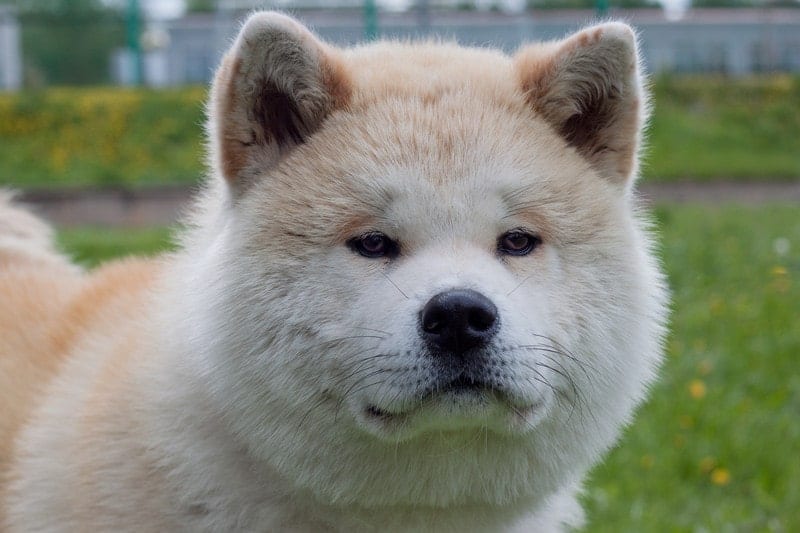
Named for having supposedly originated in the Akita province of Japan, they have been recorded to guard Japanese royalty since the 1600s, who hunted alongside their owners for fowl and other wild game. They have maintained their dignified and bold temperaments ever since.
Owning an Akita indoors is like having a guardian of the household whose undying, sole mission in life is to serve you.
If you are considering owning and raising one of these brave and hard-willed dogs, read on to learn about the answers to some of the most common and important questions surrounding their temperament, and more.
- What It’s Like Owning an Akita?
- Differences Between Male and Female Temperaments
- Varying Akita Temperament by Type
- How to Manage Akita Temperament?
- Temperament at Home
- Temperament in the Hunting Field
- Getting Along With Other Pets and Children
- Changes in Behavior That Could Signal Health Problems
- Preparation Tips for Getting a New Akita as a Pet
- When an Akita is Properly Trained?
What It’s Like Owning an Akita?
Since they’re fiercely loyal to family members, they require proper training to not intimidate or be over-wary of strangers who visit.
Loyalty is a huge selling point of this breed, which is why it’s vital that the bond between owner and pet do not become overwhelmed by trainer and the pet instead. Harsh training methods wound the breed’s pride, too, and respectful training reciprocates respect from the Akita.
Thus, the entire point of owning an Akita is for its constant presence around family members. A lonely and isolated Akita holed in the backyard will become aggressive and mean.
They’re also quite a vocal breed, whose vocal cords can produce a variety of unique barks, howls and grunts. When they pant underneath their breath some owners swear it sounds like the Akita is talking to itself, or mumbling.
However, when they hunt, they are unusually quiet for a dog breed and tiger-like in their prowling (as well as feline-like grooming habits).
Training an Akita will help soften the edge of their caution and guard around strangers, although bear in mind that an Akita is not a social dog, and will always be a noble and dignified guardian dog instead. They have strong, bold wills and may initiate walks on their own by leading you to their leash when they want to take a walk, for example.
An Akita’s tendency for “mouthing,” or grabbing things with their mouth can be utilized for its full benefit by teaching the intelligent breed chores or tasks such as fetching the morning paper to fetching slippers.
A quick warning that this breed also sheds, a lot! Expect to be frequently vacuuming as a consequence of owning an Akita.
Differences Between Male and Female Temperaments
Akitas are known for their slightly wolfish temperaments, while being less friendly and usually wary of strangers and conversely being loyal to their owners.
Although the female is slightly smaller than the male, Akitas are prone to same-sex aggression, and will need training and proper socialization to overcome this.
Varying Akita Temperament by Type
While Japanese and American Akitas are fairly easy to distinguish by appearance, they are also quite similar in temperament save for one difference: the American Akita is considered to be slightly more friendly than the reserved Japanese type.
How to Manage Akita Temperament?
An Akita has a strong will, for which it is not recommended to be attempted to raise by beginners. It will try to dominate you if you do not provide it with the proper, strong and firm discipline it needs.
Extra patience is a must when training the Akita, since its pride and stubbornness offers an extra level of tries and resistance to training compared to other dog breeds.
Temperament at Home
Akita dogs can handle isolation and tolerate being alone when the family is out really well. They are incredibly affectionate with family members and will become strongly loyal to them over time, and are kid friendly and safe for children.
However, this does not mean they thrive being alone for a long time, say, in the backyard. They will be happy and healthy dogs for as long as they are in the presence of family members indoors, and included in family activities.
Their energy level is quite high compared to other dog breeds and will tend to get bored if not taken outside for exercise daily. When an Akita gets bored it will display destructive behaviors such as digging, chewing, aggression or barking.
Temperament in the Hunting Field
Akitas are fierce and not too willing to give up or back down from a challenge while out on the field, having been historically used for hunting boar, deer and even black bears. They are still being used for hunting today.
Their confidence is not entirely unfounded, as their dense fur protects them from the sharp claws and fangs of more dangerous prey, and they don’t have a tendency to be frightened, not even of bears or tigers.
This talent in hunting, as can be expected, translates well into play with their owners. However, their boldness as well as iron wills can pose a challenge for trainers, whose patience will be tested by the Akita’s stubbornness.
Getting Along With Other Pets and Children
As mentioned previously, the Akita breed is a kid-friendly breed and should pose no danger to small children in the household.
However, if screened for having lived in an abusive or neglected household, the dog may pose a danger and playtime will have to be supervised around small children at all times.
If improperly trained an Akita will chase the other pets around the house. However, if socialized and raised properly they can interact with other dog breeds owned in the household with minimal to no problems.
Changes in Behavior That Could Signal Health Problems
Aggression should be a red flag that could indicate a pet from an abusive or neglected household. Be aware that this breed also is more prone to dental problems than other breeds, and will require frequent brushing of the teeth.
However, it can also be a symptom of hyperthyroidism, where the dog will manifest other signs such as hair loss, dry skin and coat, weight gain and other skin diseases. Fear in the Akita is also rarely seen, and may also be a consequence of hyperthyroidism.
Akita’s are also prone to skin diseases more often than other dog breeds, and thus spotting of diagnosis as well as treatment will have to be issued early and sometimes over long-term for the best results.
Issues in movement from your pet can signify arthritis, problems with bone or joints, or obesity, as this breed requires a low-calorie diet.
Squinting, or watery eyes can indicate an arrival of late-age blindness, glaucoma or cataracts.
If an Akita is ignoring you, you may want to have its brain waves analyzed for deafness, as silence and deafness have been observed in this breed’s bloodline.
Preparation Tips for Getting a New Akita as a Pet
Akitas are recommended for experienced owners, therefore having raised dogs before, especially if they were more aggressive or strong-willed dogs would be a great prerequisite for owners interested in owning an Akita.
Beyond the common advice to dog-proof your house, it is vital that you get your Akita ready for socialization and training immediately, especially if you have other dogs or pets in the house.
This extends to leash training as well as the obeying of your commands, both which are imperative.
Be prepared for extensive grooming, since as stated previously this breed sheds a lot. Make sure you or someone else in the family is constantly there to provide attention, companionship during rest and playtime outside when the dog requires its exercise.
You will also need to teach your pet crating, which is teaching the Akita where he can or cannot be in the house. If you simply allow him to roam the house he will adopt the mentality that he can be where he wants, when he wants.
Know the proper type of food to feed Akitas, which is usually a nutritious, low-calorie kibble food as opposed to wet foods which can hurt their stomach when it expands and cause other dietary issues. Fasting once a week can be included in your Akita’s diet to prevent obesity.
When an Akita is Properly Trained?
An Akita that is properly trained will lose its aggression and unfriendliness with other dog breeds, and will be slightly less wary of strangers visiting the household.
They won’t take off or try to lead with the leash, and will not ignore spoken word orders from the owner as well.
Being an intelligent breed, they can also learn a variety of tricks and tasks, from being told to “sit,” to fetching items and even greeting owners outdoors at set times.
You Might Also Like:
- Are Akitas Easy to Train? (Explained and Quick Facts)
- Can Akitas Run Long Distances? (Explained and Quick Facts)
- The Ultimate Guide to What Akitas Can (and Can’t) Eat
- Should You Neuter Your Akita? (Explained and Quick Facts)
- Can Akitas Swim? (Explained and Quick Facts)
Mike is the Founder of Familylifeshare. Mike is well-knowledged in marriage, parenting, dogs, blogging and committed to sharing his knowledge and expertise with his readers. Know more about Mike from here.


